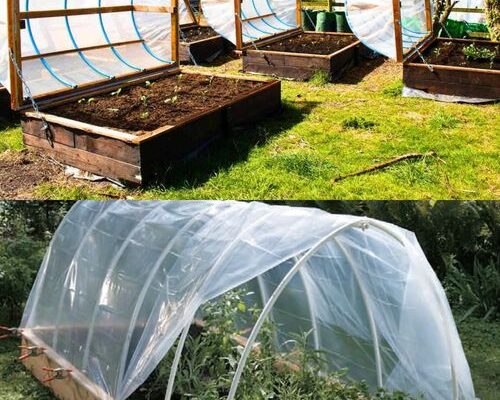Creating a hinged hoophouse for your raised bed garden offers numerous benefits, including extended growing seasons, protection from harsh weather, and pest management. This detailed guide provides step-by-step instructions to help both beginners and seasoned gardeners construct a functional hoophouse with ease.
Materials Needed:
- PVC pipes (1/2 inch diameter)
- Heavy-duty plastic sheeting (6 mil)
- Hinges
- Screws (stainless steel)
- Wooden planks (for the raised bed frame)
- Pipe clamps
- UV-resistant zip ties
- Tools: Drill, saw, measuring tape, staple gun

Step 1: Prepare Your Raised Bed Construct a sturdy raised bed using wooden planks and ensure it’s positioned in a sunny spot in your garden. The size of your raised bed will determine the dimensions of your hoophouse, so plan accordingly.
Step 2: Measure and Cut PVC Pipes Measure the length of your raised bed and cut PVC pipes to create hoops spanning the width of the bed. Space the hoops every 2-3 feet and gently bend the pipes before inserting them into the soil or attaching them to the wooden frame with pipe clamps.
Step 3: Install Hinges Choose one side of the raised bed as the fixed base and attach hinges to the opposite side for the hoophouse opening. These hinges will facilitate easy access to your plants.
Step 4: Attach PVC Pipes to Hinges Secure the PVC pipes to the hinged side of the raised bed using screws and pipe clamps, ensuring a firm attachment that allows for smooth opening and closing.
Step 5: Cover with Plastic Sheeting Drape heavy-duty plastic sheeting over the PVC hoops, leaving excess material to cover the ends of the raised bed. Trim the plastic as needed and secure it tightly using UV-resistant zip ties and staples.
Step 6: Secure the Plastic Sheeting Ensure the plastic sheeting is tightly secured to the PVC hoops and wooden frame to protect the interior from the elements. Bury excess plastic or secure it to the frame to prevent damage.
Step 7: Final Adjustments Test the hoophouse by opening and closing it to check for proper functionality. Make any necessary adjustments to the hinges, plastic, or frame for optimal performance.
Step 8: Ventilation Provide ventilation by rolling up the side of the plastic sheeting or installing additional vents to regulate temperature and humidity inside the hoophouse.

Maintenance Tips: -Regularly inspect the hoophouse for damage, especially after severe weather. -Replace the plastic sheeting as needed to maintain clarity and durability. -Lubricate hinges periodically for smooth operation.



